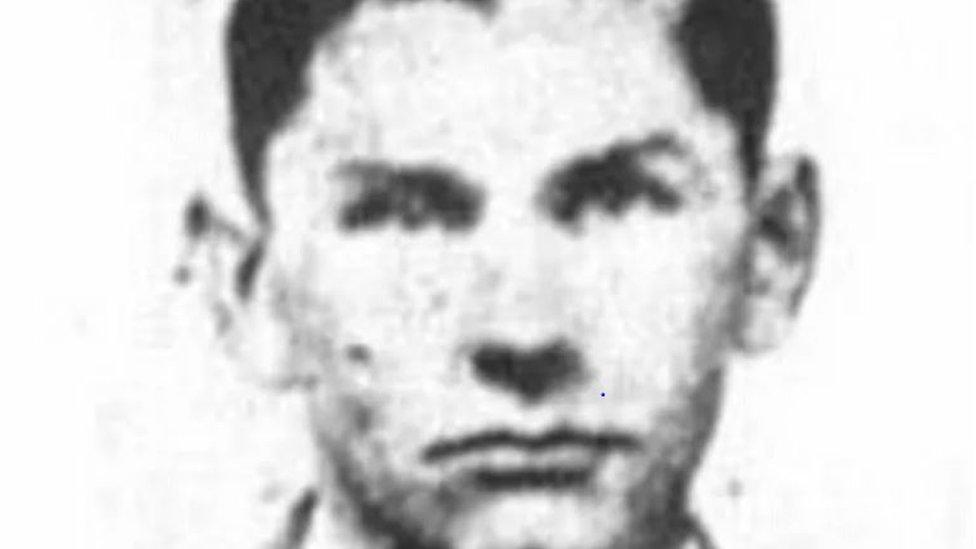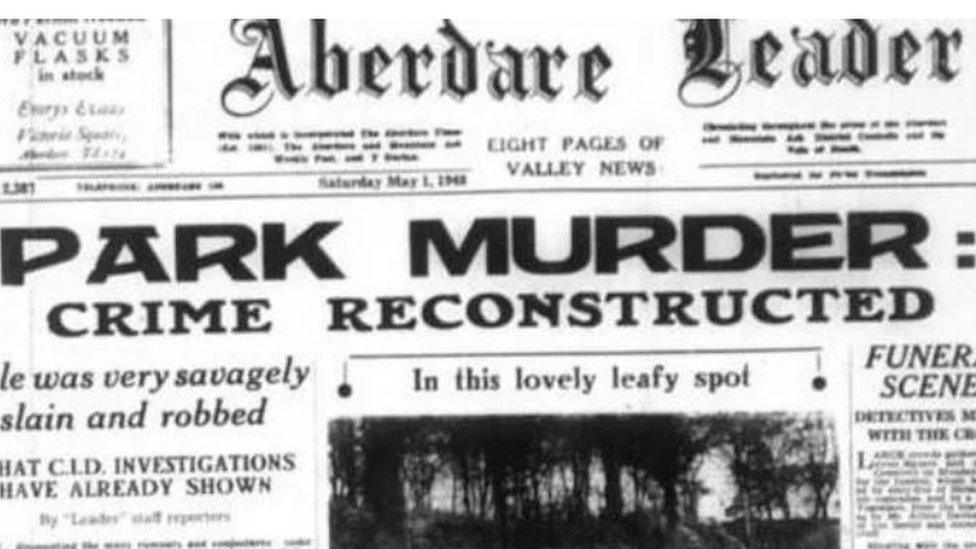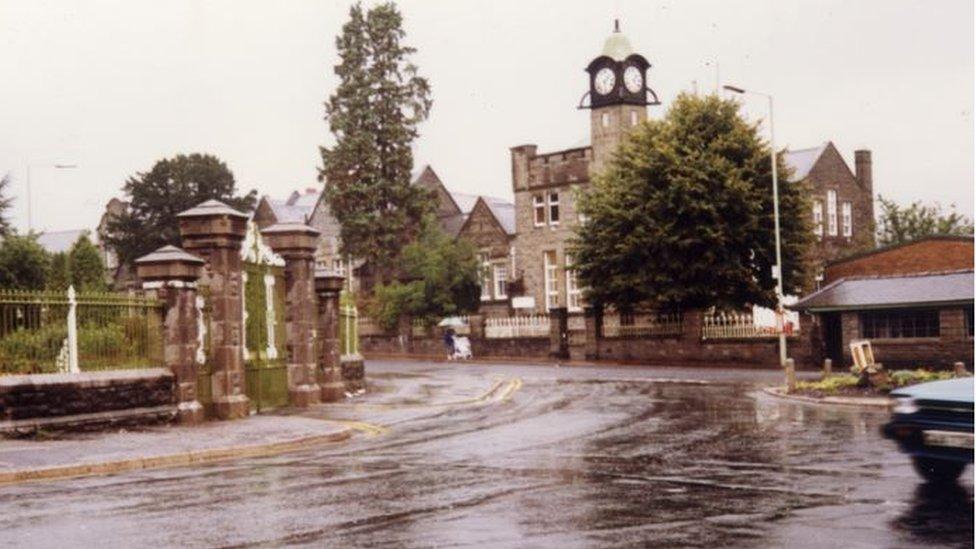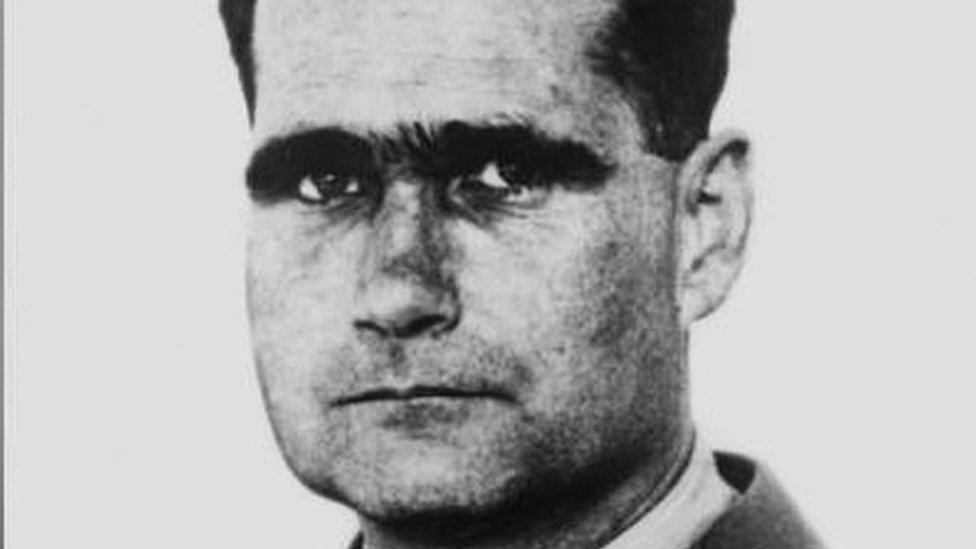Aberdare: The park murder that may have had Hitler links
- Published

Revered police detective RH Fabian caused "ripples of excitement" in the town when he arrived from London to try cracking the case
It was a frenzied murder which left locals too scared to leave their homes.
The victim was brutally stabbed 44 times, robbed, and his body dumped in the flowerbeds at Aberdare park one evening in April 1948.
Scotland Yard would send in their top man to investigate, but even he would fail to find the killer.
Meanwhile, the shocked south Wales valleys community abounded with rumours that the slaying might have been connected to Hitler and his Nazis.
The dead man's name was Jerzy Strzadala, although many who grew to know the well-liked Polish immigrant would simply refer to him as George.
He arrived from his homeland after WWII ended and began working at a colliery in Hirwaun, Rhondda Cynon Taf.
Said to have been friendly and polite to all, the 33-year-old was discovered in rhododendron shrubbery the following morning by three young boys on their way to school.
The coroner was alerted and police barricades quickly set up around the grisly scene.
As a result, those living in the area started bolting their doors in fear.
Others vowed to stay well away from the popular park altogether.
News of the murder eventually attracted the attention of Scotland Yard, whose famed chief inspector Robert Honey Fabian set up a base at one of the town's hotels to investigate.

Jerzy Strzadala was found by a group of school boys having been brutally murdered
Fabian, or RH as he was known, was something of a celebrity due to his cracking of some recent high profile crimes in London - one of which was a murder case so controversial it would eventually lead to the death penalty being abolished.
However, despite the excitement caused by his arrival, progress in finding the murderer proved painfully slow.
Even the use of ground breaking new technology - a top of the range metal detector - failed to uncover the discarded murder weapon.
The park's lake was also dredged in the hope a clue would lie buried in the silt beneath its surface, but with no luck.
Meanwhile, hundreds of door-to-door inquiries proved equally fruitless, despite some purporting to have seen a "short and thick set man aged in his late 20s" in the park around the time Strzadala had been set upon.
Indeed, Fabian's investigation would be dogged by all manner of frustrating dead-ends.

How local paper The Aberdare Leader reported the crime
The area's large contingent of eastern European mine workers - some of whom had been staying at the same hostel as Strzadala - spoke little English, making police interviews difficult.
Meanwhile, clothing found near the pit where the victim had worked - a waistcoat and trousers - would prove briefly tantalising.
But instead of having been dumped by the killer, as hoped, the garments were deemed in too good a state to have been involved in such a vicious attack.
Similarly the ace detective's spirits were buoyed when some blood-stained banknotes were stumbled upon.
Yet again though, nothing came of it.
Some doubted the blood had been Strzadala's at all, instead suggesting that the cash had simply passed through the unwashed hands of staff at the local butcher shop.
Nevertheless, there is no record of what happened after the money was sent off for forensic testing.
What some did believe, however, was that the conflict in Europe had some part to play in Strzadala's death.
'Espionage-related'
Whispers at the time suggested that the other man seen in Aberdare Park on that fateful night had also been Polish.
Some with relatives who had been alive in the area during the 40s remember talk of how the two had somehow recognised each other from the war.
The inference was that Strzadala possibly colluded with the Nazis during the fighting and had been recognised and approached by his countryman.

The main entrance to Aberdare park photographed in the 1980s
That said, there are those who believe it was the other man who had been confronted by Strzadala for having sided with Hitler's fascists.
Posting on the A Bit of Old Aberdare Facebook page one person said: "There was a theory it was espionage-related, or an old grudge carried over from Poland."
Another said they had spoken to their elderly father about the murder and he remembered the door to door inquiries and the rumours of how either Strzadala or his killer had worked as "a guard in a POW camp".
So was it a revenge killing?
Unfortunately we may never know the truth, the murder having gone unsolved to this day - despite South Wales Police announcing in 2009 that the cold case was one of several being kept open for review.
But for RH Fabian it would prove among the few times in a long and glittering career in which he failed to get his man.
He would retire from the force the following year knowing Jerzy Strzadala's killer was still out there somewhere.
And while that man's identity remains unknown, the motive behind the crime seems to offer up an even darker mystery.
- Published26 June 2022

- Published21 April 2023
